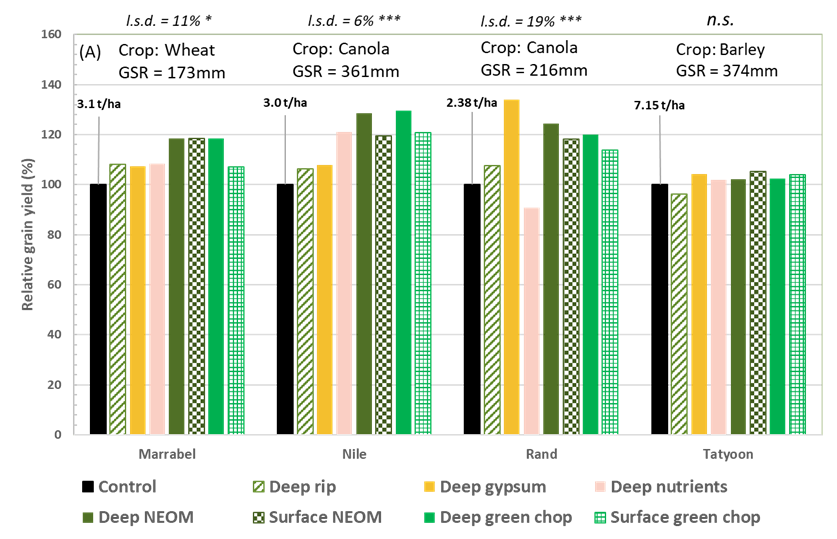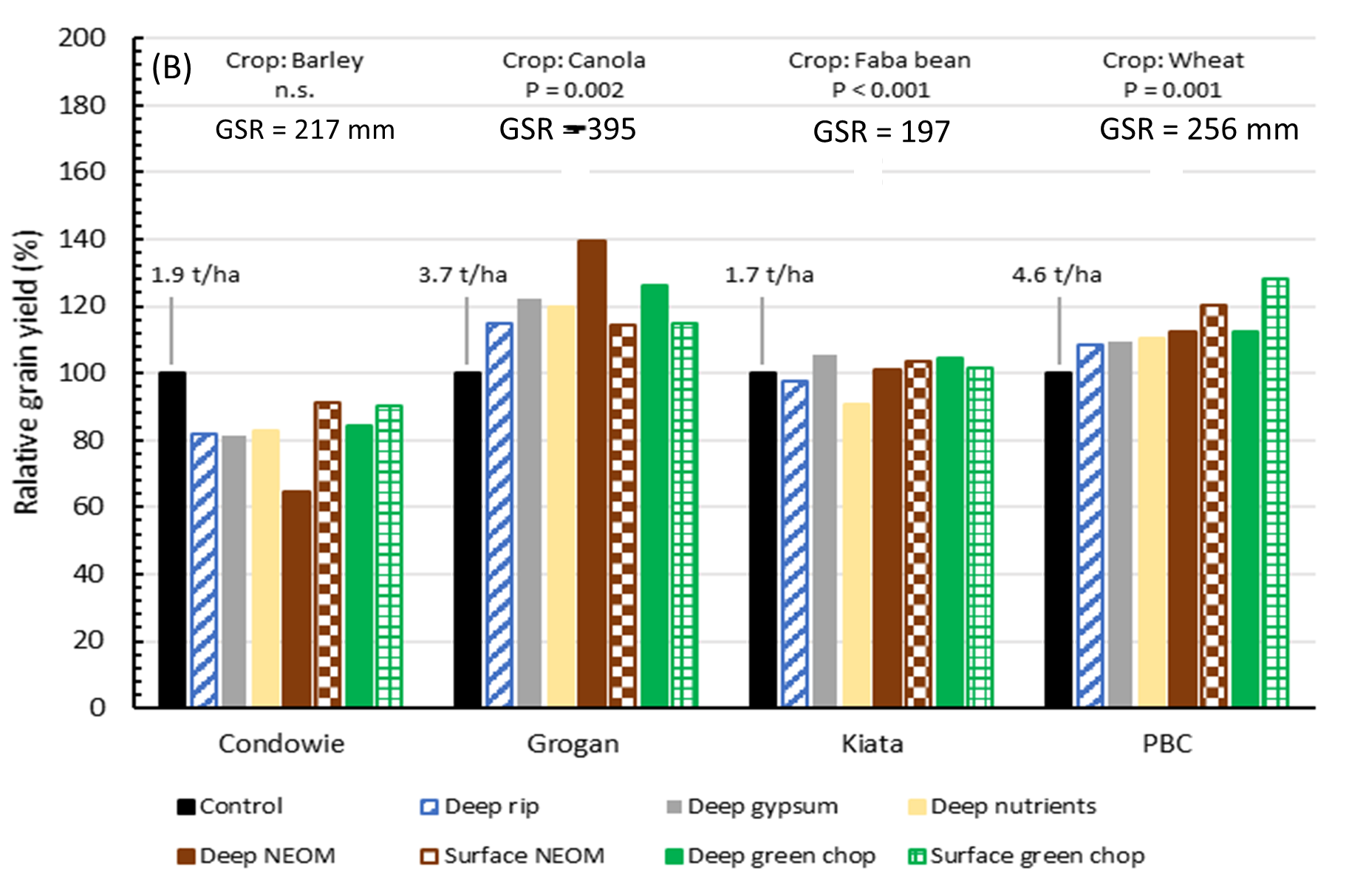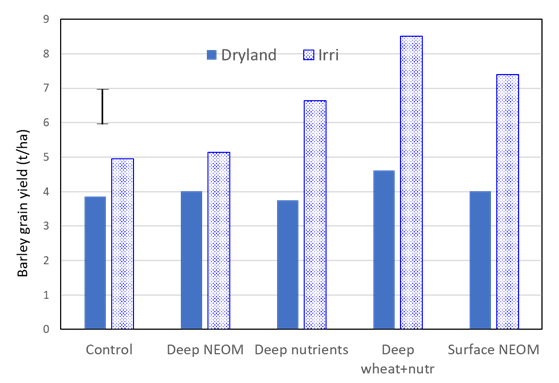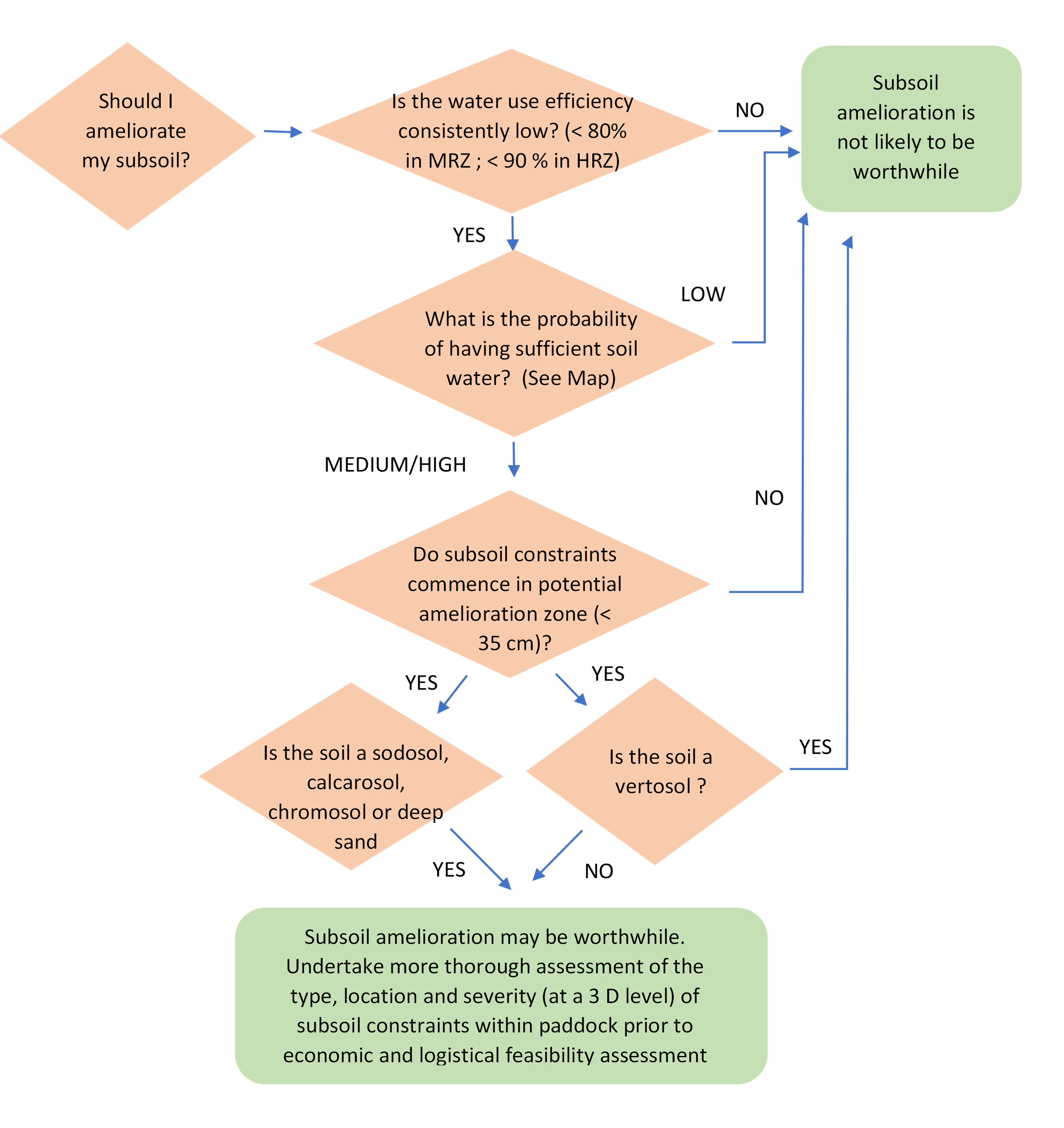Soil amelioration in medium and high rainfall regions – where will it pay
Take home messages
- Subsoil amelioration has the potential to increase yields and long-term profitability when targeted at appropriate soil conditions and climates.
- The likelihood of achieving favourable yield responses is low on heavy clay topsoils, medium rainfall environments (<420mm annual rainfall) or if soil constraints become severe at depths greater than amelioration (typically >35cm).
- Subsoil amelioration should be approached with knowledge of the location and severity of soil constraints in a paddock, including how deep they are, and following appropriate economic analysis. Following this approach can markedly reduce production and financial risk associated with subsoil amelioration.
Background
Many cropping soils in south-eastern Australia contain a range of subsoil physicochemical constraints including sodicity (dispersion), high electrical conductivity and boron. These can limit root growth and water and nutrient uptake, resulting in crops not achieving their full water limited yield potential. Research over the past three decades has shown the potential to overcome these soil constraints using various ameliorants, a process sometimes termed ‘subsoil manuring’. However, the large upfront costs associated with subsoil amelioration (up to $1500/ha; Sale and Malcolm 2015), logistical constraints such as availability of manures, and highly variable yield responses has resulted in few growers adopting this technology.
An analysis of factors that limit the economic and technical viability of subsoil amelioration has identified four key determinants:
- the need for reliable predictions of where soil amelioration will and, just as importantly, will not improve yields
- the need to reduce high upfront costs of implementation ($/ha)
- ready access to (relatively) cheap ameliorants, preferably sourced on-farm
- the need for a soil ameliorant to benefit several subsequent crops (residual value) to justify the investment.
This paper reports key findings from a GRDC project that addresses the four determinants of whether subsoil amelioration is a feasible management option for a grower. This project focused on medium and high rainfall cropping systems in south-eastern Australia, with a particular emphasis on clay soils. Another project, known as the ‘Sandy Soils Project’ (CSP00203; Therese McBeath) focuses on soil amelioration on sandy soils and the low/medium rainfall zone. We propose that the learnings outlined in this paper provide growers with the potential to effectively manage economic risk associated with soil amelioration. To assist growers and advisers in deciding whether to trial ameliorating or not, we have developed a preliminary decision tree.
Method
Results from two components of the DAV00149 project are used. The first involved a series of field trials established at two sites in 2017 and a further six sites in 2018 (Rand and Grogan in southern New South Wales, Condowie and Stansbury in South Australia, Nile in Northern Tasmania, and Kiata, Tatyoon and PBC (Horsham) in western Victoria), with four sites classified as MRZ and four as HRZ. Sites were predominantly classified as Sodosols, but there was also Vertosols (Kiata and PBC) and a Calcarosol (Condowie). All sites had sodic (exchangeable sodium percentage >6%) subsoils, but the severity and depth where sodicity first became substantial in the soil profile varied with site. Each trial assessed a range of amelioration treatments including both animal manure and plant based organic matter (lucerne or field pea), gypsum and fertiliser that were applied to either the topsoil or incorporated into subsoils (typically 25–40cm depth), which were then compared to both a ‘deep ripping only’ and a non-ameliorated control. Ameliorants were applied once, and soil and crops subsequently monitored for five years. Crop and soil data from these experiments were used to both assess interactions between amelioration (depth and type), soil and seasonal conditions on grain yield, as well as use in subsequent APSIM simulation modelling. The second component comprised a detailed analysis using both generalised linear mixed modelling (GLMM), and generalised additive modelling (GAM) regression procedures of a range of historical data sets and some field trials (n = 30 sites with up to six seasons monitored). These trials were conducted in south-eastern Australia from 1986 to 2020 and examined the effect of applying an ameliorant (manure or plant based) to the subsoil (typically 30 to 40 cm depending on soil conditions) on grain yields.
Results and discussion
Summary of yield responses from MRZ and HRZ on clay soils
Yield responses ranged from none (or even negative) to greater than 70% for a range of crops including wheat, barley, canola and faba bean, encompassing more than 40 site x years trials. However, the majority of yield gains were between 15% and 25% and tended to occur only at particular sites. The higher magnitude yield responses tended to be in the HRZ (Figure 1), reflecting higher yielding crops. High relative responses were also recorded in the MRZ (see Figure 2), but absolute yields were lower and poor responses much more common.
There was a strong trend for most sites to either respond to soil amelioration or not, for example, Rand and Nile = positive response, Condowie and Kiata = no response over all or most years of the trial. Responsiveness was attributed principally to a combination of soil water availability and soil properties (texture and location/severity of physicochemical constraints within the soil profile). The response of two MRZ sites (Grogan, NSW and PBC, Victoria) exemplified this relationship between water and soil properties, showing no response in seasons with low growing season rainfall (GSR) but highly responsive in others, for example, 2021 – see Figure 1b.
We subsequently investigated soil moisture dynamics in the topsoil (0–40cm) using (APSIM) simulation. This modelling indicated that a combination of high clay content in the topsoil and low rainfall resulted in long periods when there was often insufficient soil water in the profile.


Figure 1. Relative grain yield response (%) of crops to different soil amelioration strategies with amendments applied either to the soil surface or subsoil (deep) at four sites in (A) the HRZ and (B) MRZ of south-eastern Australia. GSR = growing season rainfall (mm). The relative yield of the control treatment (no amelioration) = 100% with the value above this treatment expressed as grain yield (t/ha). ‘NEOM’ = animal manure pellets; ‘green chop’ = lucerne or field pea hay pellets. Organic amendments applied at either20t/ha (HRZ) or 15t/ha (MRZ); Deep nutrients represents the equivalent rate of N (and P) applied in the green chop. n.s. = not significant (at P = 0.05)
to enable decomposition of organic ameliorants, as well as a general lack of plant available water in the subsoil. This relationship between soil water availability (especially the impact of texture) is further supported by data from another project (DJP2209-002RTX: see GRDC Update presentation by Daniel Hendrie). In this project, significant responses (30-65%) to amelioration have been recorded on sections of two paddocks with sandy topsoils (Sodosols), where the amelioration zone is more likely to wet up due to lower water holding capacity. In contrast, those sections of the same paddock containing heavy clay topsoils (Vertosols), which are more difficult to wet up, were non-responsive.
Experimentation at one of the MRZ sites (PBC), where sufficient irrigation was applied prior to sowing to wet the subsoil microplots, resulted in significant crop and yield responses by barley to soil amelioration (Figure 2), whereas under ‘dryland conditions’, no response was recorded (Hart et al. 2022).

Figure 2. Grain yield response of barley to different soil amelioration treatments at the PBC site in 2020 (ameliorants were applied in 2018) under ‘dryland’ and irrigated subplots. NEOM = chicken litter pellets. Vertical bar is lsd (P = 0.05).
This modelling is being used to generate maps of south-eastern Australia, based on soil type and long-term climate records, of the likelihood that there will be sufficient soil water in the zone of soil amelioration (ameliorants typically placed at 30–40cm depth) for subsoil amelioration to have the potential to improve yields.
A key consideration in determining whether soil amelioration is likely to benefit yield and profit is the depth within the profile at which soil physicochemical constraints occur. The severity of most physicochemical constraints intensifies with soil depth, which reflects increasing clay content (Adcock et al. 2007). Current subsoilers have limited ability to physically place large quantities of ameliorants (15–20t/ha), whether it is gypsum or organic matter, at soil depths greater than 35cm. This is especially the case on dense clay soils in MRZ areas in most years, although this is less of an issue in HRZ due to the higher soil water levels remaining over the summer fallow which reduce soil strength. Examination of DAV00149 sites that regularly failed to produce yield responses to soil amelioration indicated that constraints such as sodicity (dispersion) did not become potentially limiting to most crops until depths >60 cm were reached. This was particularly the case with Vertosols (for example, Kiata). In contrast, Sodosols, Calcarosols and Chromosols (except where animal manures are applied) (DAV00149 SAGI analysis), duplexes (Hendrie et al. 2023) and sandy soils (Unkovich et al. 2023) tend to be consistently more responsive to soil amelioration. This soil type effect could be due to the ability of limited rainfall events to wet the amelioration zone, ease of inserting ameliorants at depth, or other factors e.g. overcoming high soil strength (Unkovich et al 2023).
The knowledge developed in these trials has been used to develop a simple decision tree when assessing whether to ameliorate a subsoil or not (Figure 3). The first factor to consider is whether soil constraints are consistently limiting achievement of the rainfall-limited yield potential over several seasons (for example, through use of header yield maps). Due to high upfront costs, most soil amelioration strategies require a ‘pay-back’ period of three to four seasons. Similarly, the relative size of this yield gap needs to be greater in lower yielding environments, for example MRZ compared to HRZ systems, as the size of potential yield responses (t/ha) to amelioration are inherently smaller due to less rainfall. The decision tree focuses primarily on biophysical determinants (namely, soil type and properties, soil water availability) before moving onto more detailed mapping and soil analysis. Only then are logistical and financial considerations, for example availability and costs of suitable ameliorants, considered.

Figure 3. A decision support framework for assessing whether to ameliorate subsoils for medium and high rainfall zones of south-eastern Australia.
Conclusion
A key feature of subsoil constraints, which generally intensify with increasing soil profile depth and clay content, is that crop growth will only be reduced when subsoil water is present (Nuttall & Armstrong 2010). Similarly, subsoil amelioration will only mitigate a soil constraint if sufficient soil water is present in the amelioration zone and that available machinery can readily place a suitable ameliorant (organic matter or gypsum) in direct proximity to the constraint/s. Current continuous cropping systems based on heavy clay soils in medium (<420mm annual) rainfall zones of south-eastern Australia will rarely have sufficient water present to drive soil amelioration and boost grain yields. However, in regions with higher rainfall and soil types that are characterised by coarser texture topsoils and physicochemical constraints being located within the top 35 cm, detailed soil mapping and analysis that accounts for spatial variability in soil constraints within a paddock (see Hendrie et al. 2023) and associated economic analysis is justified and can potentially produce reliable responses to soil amelioration and improved profitability.
Acknowledgements
We would like to acknowledge the GRDC, The Australian Government (through The National Landcare Program) and our various host organisations for co-funding this research and analysis through ‘Understanding the amelioration processes of the subsoil application of amendments in the Southern Region (DAV00149) and ‘Soil Amelioration Extension Program in Victoria’s MRZ and HRZ‘ (NLP 4-GKXBV5N/DJP2204-011SAX). We are also very grateful to our numerous grower co-operators who have hosted our field trials and the range of technical staff for helping conduct the field trials.
References
Adcock D, McNeill AM, McDonald GK, Armstrong RD (2007) Subsoil constraints to crop production on neutral and alkaline soils in south-eastern Australia: a review of current knowledge and management strategies. Australian Journal of Experimental Agriculture 47, 1245-1261.
Hendrie D, Stott K, Armstrong R, Crawford D, Akpa S, McCaskill M, Khanal U, Keane D, Munn M, Perris R (2023) Tailoring subsoil amelioration to paddock zones in southern Australia: a two year update. GRDC Adviser Update, Bendigo 21-22nd February, 2023.
Nuttall JG and Armstrong RD (2010) Impact of subsoil physicochemical constraints on crops is reduced during dry seasonal conditions. Australian Journal of Soil Research 48, 125-139.
Sale P, Malcolm B (2015) Amending sodic soils using subsoil manure: economic analysis of crop trials in the high rainfall zone of Victoria. Australian Farm Business Management Journal 12, 22-31.
Unkovich M, McBeath T, Moodie M, MacDonald LM (2023) High soil strength and cereal crop responses to deeper tillage on sandy soils in a semi-arid environment. Field Crops Research 291, 108792
Contact details
Roger Armstrong
Agriculture Victoria
Grains Innovation Park
Horsham VIC 3400
0417 500 449
roger.armstrong@agriculture.vic.gov.au
GRDC Project Code: DAV1606-001RMX, DJP2204-011SAX,
Was this page helpful?
YOUR FEEDBACK
